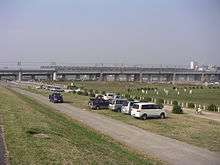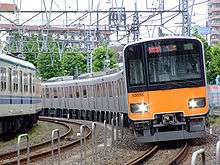Tōkyū Den-en-toshi Line
| Tokyu Den-en-toshi Line | |
|---|---|
| DT | |
|
| |
| Overview | |
| Native name | 東急田園都市線 |
| Type | Commuter rail |
| Locale | Kantō Region |
| Termini |
Shibuya Chūō-Rinkan |
| Stations | 27 |
| Daily ridership | 1,162,282 (daily, 2010)[1] |
| Operation | |
| Opened | 11 October 1963 |
| Owner | Tokyu Corporation |
| Depot(s) | Nagatsuta |
| Technical | |
| Line length | 31.5 km (19.6 mi) |
| Track gauge | 1,067 mm (3 ft 6 in) |
| Electrification | 1,500 V DC overhead catenary |
| Route diagram | ||||||||||||||||||||||||||||||||||||||||||||||||||||||||||||||||||||||||||||||||||||||||||||||||||||||||||||||||||||||||||||||||||||||||||||||||||||||||||||||||||||||||||||||||||||||||||||||||||||||||||||||||||||||||||||||||||||||||||||||||||||||||||||||||||||||||||||||||||||||||||||||||||||||||||||||||||||||||||||||||||||||||||||||||||||||||||||||||||||||||||
|---|---|---|---|---|---|---|---|---|---|---|---|---|---|---|---|---|---|---|---|---|---|---|---|---|---|---|---|---|---|---|---|---|---|---|---|---|---|---|---|---|---|---|---|---|---|---|---|---|---|---|---|---|---|---|---|---|---|---|---|---|---|---|---|---|---|---|---|---|---|---|---|---|---|---|---|---|---|---|---|---|---|---|---|---|---|---|---|---|---|---|---|---|---|---|---|---|---|---|---|---|---|---|---|---|---|---|---|---|---|---|---|---|---|---|---|---|---|---|---|---|---|---|---|---|---|---|---|---|---|---|---|---|---|---|---|---|---|---|---|---|---|---|---|---|---|---|---|---|---|---|---|---|---|---|---|---|---|---|---|---|---|---|---|---|---|---|---|---|---|---|---|---|---|---|---|---|---|---|---|---|---|---|---|---|---|---|---|---|---|---|---|---|---|---|---|---|---|---|---|---|---|---|---|---|---|---|---|---|---|---|---|---|---|---|---|---|---|---|---|---|---|---|---|---|---|---|---|---|---|---|---|---|---|---|---|---|---|---|---|---|---|---|---|---|---|---|---|---|---|---|---|---|---|---|---|---|---|---|---|---|---|---|---|---|---|---|---|---|---|---|---|---|---|---|---|---|---|---|---|---|---|---|---|---|---|---|---|---|---|---|---|---|---|---|---|---|---|---|---|---|---|---|---|---|---|---|---|---|---|---|---|---|---|---|---|---|---|---|---|---|---|---|---|---|---|---|---|---|---|---|---|---|---|---|---|---|---|---|---|---|---|---|---|---|---|---|---|---|---|---|---|---|---|---|---|---|---|---|---|---|---|---|
| ||||||||||||||||||||||||||||||||||||||||||||||||||||||||||||||||||||||||||||||||||||||||||||||||||||||||||||||||||||||||||||||||||||||||||||||||||||||||||||||||||||||||||||||||||||||||||||||||||||||||||||||||||||||||||||||||||||||||||||||||||||||||||||||||||||||||||||||||||||||||||||||||||||||||||||||||||||||||||||||||||||||||||||||||||||||||||||||||||||||||||

The Tokyu Den-en-toshi Line (東急田園都市線 Tōkyū Den'entoshi-sen) is a major commuter line operated by the private railway operator Tokyu Corporation and connecting south-western suburbs of Tokyo and neighbouring Kanagawa Prefecture, with its western terminus of Chūō-Rinkan, to a major railway junction of western downtown Tokyo, Shibuya. At Shibuya, nearly all the trains continue on the Tokyo Metro Hanzomon Line.
The line's color on maps and station guides is green, and stations carry the prefix "DT" followed by a number.
Operation
Nearly all trains on the Den-en-toshi Line are operated through to/from the Tokyo Metro Hanzomon Line using Tokyu, Tokyo Metro, and Tobu Railway 10-car EMUs. Around half of them continue beyond Oshiage, the terminus of the Hanzomon Line, to the Tobu Skytree Line (Kita-Koshigaya Station, Kita-Kasukabe Station and Tōbu-Dōbutsu-Kōen Station), Tobu Isesaki Line (Kuki Station), and Tōbu Nikkō Line (Minami-Kurihashi Station).
Service types
The following three types of service are operated on the line.
- Local (普通 Futsū) (L)
- Stop at all stations. Eight services per hour in each direction during the daytime.
- Semi-Express (準急 Junkyū) (SE)
- In up direction on weekday mornings only.
- Express (急行 Kyūkō) (Ex)
- Four trains per hour in each direction during the daytime.
Through trains to Oimachi Line
On weekends, two six-car express trains per hour are operated to/from Ōimachi and Nagatsuta. Also, a few trains are operated through to/from the Tokyu Oimachi Line to utilize forwardings to/from Saginuma depot, up to Ōimachi in the mornings, and down to Saginuma in the late evenings. These formations are 5-car sets, unlike the 10-car trains normally used on the line. A few express trains in holidays also serve from Chūō-Rinkan in the mornings, down in the evenings.
Stations
▲ indicate stations where trains stop on weekends and public holidays only.
| No. | Name | Japanese | Distance (km) | L | SE | Ex | Transfers | Location | |
|---|---|---|---|---|---|---|---|---|---|
| ↑ Through-services to/from Z Tokyo Metro Hanzomon Line ↑ | |||||||||
| DT01 | Shibuya | 渋谷 | 0.0 | O | O | O |
|
Shibuya | Tokyo |
| DT02 | Ikejiri-Ōhashi | 池尻大橋 | 1.9 | O | O | | | Setagaya | ||
| DT03 | Sangen-Jaya | 三軒茶屋 | 3.3 | O | O | O | SG Tokyu Setagaya Line | ||
| DT04 | Komazawa-Daigaku | 駒沢大学 | 4.8 | O | O | | | |||
| DT05 | Sakura-shimmachi | 桜新町 | 6.3 | O | O | | | |||
| DT06 | Yōga | 用賀 | 7.6 | O | O | | | |||
| DT07 | Futako-Tamagawa | 二子玉川 | 9.4 | O | O | O | OM Tokyu Oimachi Line | ||
| DT08 | Futako-Shinchi | 二子新地 | 10.1 | O | ↑ | | | Takatsu-ku, Kawasaki | Kanagawa | |
| DT09 | Takatsu | 高津 | 10.7 | O | ↑ | | | |||
| DT10 | Mizonokuchi | 溝の口 | 11.4 | O | O | O |
| ||
| DT11 | Kajigaya | 梶が谷 | 12.2 | O | ↑ | | | |||
| DT12 | Miyazakidai | 宮崎台 | 13.7 | O | ↑ | | | Miyamae-ku, Kawasaki | ||
| DT13 | Miyamaedaira | 宮前平 | 14.7 | O | ↑ | | | |||
| DT14 | Saginuma | 鷺沼 | 15.7 | O | O | O | |||
| DT15 | Tama-Plaza | たまプラーザ | 17.1 | O | O | O | Aoba-ku, Yokohama | ||
| DT16 | Azamino | あざみ野 | 18.2 | O | O | O | ■ Yokohama Municipal Subway Blue Line | ||
| DT17 | Eda | 江田 | 19.3 | O | ↑ | | | |||
| DT18 | Ichigao | 市が尾 | 20.6 | O | ↑ | | | |||
| DT19 | Fujigaoka | 藤が丘 | 22.1 | O | ↑ | | | |||
| DT20 | Aobadai | 青葉台 | 23.1 | O | O | O | |||
| DT21 | Tana | 田奈 | 24.5 | O | ↑ | | | |||
| DT22 | Nagatsuta | 長津田 | 25.6 | O | O | O | Midori-ku, Yokohama | ||
| DT23 | Tsukushino | つくし野 | 26.8 | O | ↑ | | | Machida | Tokyo | |
| DT24 | Suzukakedai | すずかけ台 | 28.0 | O | ↑ | | | |||
| DT25 | Minami-Machida | 南町田 | 29.2 | O | O | ▲ | |||
| DT26 | Tsukimino | つきみ野 | 30.3 | O | ↑ | | | Yamato | Kanagawa | |
| DT27 | Chūō-Rinkan | 中央林間 | 31.5 | O | O | O | |||
Footnotes
- ↑ The transfer between the Hanzomon Line and the Ginza Line at Shibuya is an out-of-system transfer since they are separate stations. Due to the distance between the two stations, transfers between the two lines are announced at Omotesando.
Rolling stock
- Tokyo Metro 8000 series
- Tokyo Metro 08 series
- Tokyu 2000 series
- Tokyu 5000 series
- Tokyu 8500 series
- Tokyu 8590 series
- Tobu 30000 series
- Tobu 50050 series
From spring 2018, new Tokyu 2020 series ten-car EMUs are scheduled to enter service on the Tokyu Den-en-toshi Line.[2]
 Tokyo Metro 8000 series
Tokyo Metro 8000 series Tokyo Metro 08 series
Tokyo Metro 08 series Tokyu 2000 series
Tokyu 2000 series Tokyu 5000 series
Tokyu 5000 series Tokyu 8500 series
Tokyu 8500 series Tokyu 8590 series
Tokyu 8590 series- Tobu 30000 series
 Tobu 50050 series
Tobu 50050 series
History
Prewar predecessors
On March 6, 1907, the Tamagawa Electric Railway (玉川電気鉄道 Tamagawa Denki Tetsudō, "Tamaden") opened the first section of the Tamagawa Line (玉川線) tramway (not to be confused with today's Tokyu Tamagawa Line) between Shibuya and what is now Futako-Tamagawa, using 1,372 mm (4 ft 6 in) gauge. The branch from Sangen-Jaya Station opened on January 18, 1925, and was split off into the present Tokyu Setagaya Line in 1969.
Tama Den-En-Toshi Plan
In 1953, Tokyu Group president Keita Gotō unveiled a "new town" planning scheme called the South-Western Area Development Plan. He envisioned new railway and freeway infrastructure (the latter being realized as the Tōmei Expressway) and large, clean houses for commuters working in Tokyo.
Development of the line
Through service was extended beyond Suitengūmae to Oshiage on March 19, 2003, allowing through service with the Isesaki Line and Nikkō Line of Tobu Railway.
Tokyu has expanded the line to four tracks from Futako-Tamagawa to Mizonokuchi; most trains of the Ōimachi line run through this section to Mizonokuchi, with some local trains making the intermediate stops. This service began on June 2009, postponed from fiscal 2007. Ōimachi line trains, which are 5- or 6-car sets, will then run between Ōimachi and Mizonokuchi.[3]
Future developments
Platform edge doors are scheduled to be installed at all stations on the line by 2020.[4]
References
- ↑ Tokyu ridership in 2010 Train Media (sourced from Tokyu) Retrieved May 28, 2012.
- ↑ 大井町線の急行運転 accessed March 26, 2008
- ↑ 2020年を目標に東横線・田園都市線・大井町線の全64駅にホームドアを設置します [Platform edge doors to be installed at all 64 stations on Toyoko Line, Den-en-toshi Line, and Oimachi Line]. News release (in Japanese). Japan: Tokyu Corporation. 9 January 2015. Retrieved 31 July 2015.
Coordinates: 35°31′55″N 139°29′40″E / 35.53194°N 139.49444°E